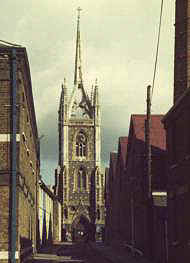Culpeper Connection
Sir Thomas
Culpeper10 of Bedgebury was granted Faversham
Abbey
and Convent by Henry VIII during the Dissolution of the
Monasteries in about 1536. The Abbey was one of the few churches
outside London where a King (Stephen) was buried.
Bigger than Rochester or Gloucester Cathedrals, it was
demolished immediately after the Dissolution and its
masonry shipped over to the English town of Calais to
strengthen its fortifications against the French - who
nonetheless captured it 20 years later. It appears unlikely
that the Culpepers ever lived there, but some of the riches of Bedgebury
Manor may well have come from the Abbey.
 St.
Mary of Charity Church
St.
Mary of Charity Church
Faversham's
parish church, St. Mary of Charity (pictured at the right), is the largest, or second largest, in Kent,
attesting the town's importance in medieval times. The
church was founded prior to the Conquest, and given by
William the Conqueror to the abbey of St. Augustine, at
Canterbury. The present edifice is a spacious cruciform
structure of flint, partly in the decorated, and partly in
the later style of English architecture, with a light tower
at the west end, crowned with pinnacles, and surmounted by
an octagonal spire, seventy-three feet high. The monuments are
numerous, but not particularly interesting. It is located
close to the site of the old Abbey.
Faversham
Location: On the M2, 25 miles NE of
Goudhurst and 18 miles ENE of Maidstone.
National Grid Coordinates: TR
010 610
1831 Topographical Dictionary:
FAVERSHAM, or FEVERSHAM, a sea port, market town, and
parish, having separate jurisdiction, locally in the hundred
of Faversham, lathe of SCRAY, county of KENT, containing
4208 inhabitants, of which number, 3919 are in the town of
Faversham, 9 miles (W.) from Canterbury, 18 (E.N.E.) from
Maidstone, and 47 (E.) from London, on the road to Dover.
This town is of great antiquity, having been inhabited by
the Britons prior to the Roman invasion. It was held in
royal demesne in 811, and is called, in a charter granted by
Kenulf, King of Mercia, “The king's little town of
Febresham.” In 930, King Athelstan held a council here,
“to enact laws, and devise methods for their future
observance.” It is returned in Domesday-book as being held
by William the Conqueror, by the name of Favreshant; and he
is said to have given the advowson to the abbey of St.
Augustine, in Canterbury, and the manor to one of his
favourite Normans, as a reward for his services. In 1147; a
celebrated abbey for twelve Cluniac monks was founded here
by Stephen, who, with Matilda, his consort, and his eldest
son, Eustace, Earl of Boulogne, were interred within its
walls, as were also several other persons of renown.
The
town has obtained peculiar privileges, and numerous charters
from various kings. Selden states that the endowments and
privileges granted by Stephen were confirmed by successive
sovereigns, and that the abbots sat in thirteen
parliaments, in the reigns of Edward I and Edward II, but
that, on account of their reduced state and poverty, they
ceased to do so after the eighteenth year of the latter
monarch's reign.
In 1539, the year after its surrender, the chief parts of
the monastery were destroyed, and the ground on which it
stood was granted to Sir Thomas Cheney, Lord Warden of the
cinque-ports, together with some adjoining lands.
James
II having been seized at Shellness point, on his first
attempt to quit the kingdom, after the landing of the Prince
of Orange, in 1688, was detained at Faversham, and
subsequently escaped from Rochester.
Faversham has long been distinguished for its
manufacture of gunpowder, which is said to have been
established here prior to the reign of Elizabeth.